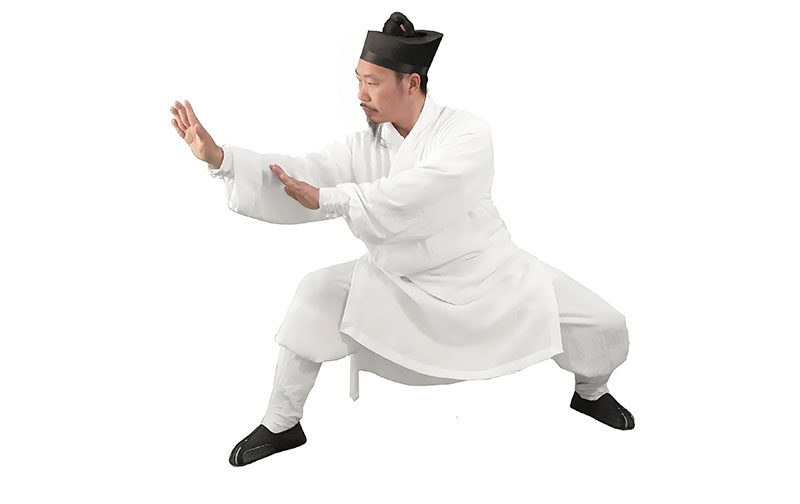
Ada postur tubuh yang tinggi dan rendah saat berlatih Tai Chi. Postur tubuh seperti apa yang harus dipilih saat berlatih? Ini adalah pertanyaan yang perlu dipertimbangkan secara serius. Orang yang baru mengenal Tai Chi sering kali berpikir bahwa postur tubuh yang rendah berarti kung fu yang baik, dan postur tubuh yang tinggi berarti tidak memiliki kung fu, dan mereka hanya berdiri untuk berlatih tinju. Faktanya, tingkat kung fu dan tingkat postur tubuh saat berlatih tinju tidak dapat berbanding lurus atau berbanding terbalik.
Menurut generasi tua, postur untuk berlatih tinju dibagi menjadi postur rendah, sedang, dan tinggi, yang masing-masing memiliki kelebihan dan keunggulannya sendiri. Sasaran setiap tahap latihan tinju berbeda, dan tinggi postur juga berbeda. Terutama saat berlatih Tai Chi tradisional, Anda harus memiliki pemahaman yang jelas tentang hal ini agar dapat berlatih tinju dengan jelas.
Berikut ini adalah deskripsi posturnya.
1. Latihan postur tubuh rendah
Berlatih tinju dengan postur rendah memiliki intensitas latihan yang tinggi dan menghabiskan banyak energi fisik. Ini adalah pelatihan intensif kung fu tubuh bagian bawah. Misalnya, rentang gerak sendi pinggul meningkat; dukungan anggota tubuh bagian bawah diperkuat; itu kondusif untuk melatih fleksibilitas pinggang dan pinggul. Ketika berlatih tinju, posturnya rendah, yang kondusif untuk menggerakkan pusat gravitasi ke bawah dan menstabilkan tubuh bagian bawah. Ketika berlatih tubuh bagian bawah dalam posisi kekuatan rendah, Anda juga harus memperhatikan spesifikasi dan standar rutinitas tinju, perubahan arah tinju, dan meletakkan dasar yang kuat dalam bentuk tubuh, gerak kaki, dan bentuk tangan. Ini adalah tahap mempelajari aturan dan berlatih kung fu. Berlatih Tai Chi dalam posisi kekuatan rendah adalah untuk meregangkan otot dan tulang, dan melatih otot, tulang, dan penampilan. Ketika berlatih dalam posisi kekuatan rendah, adalah tabu untuk membuat posisi tinju berfluktuasi. Kecuali untuk posisi berdiri dan gerakan mandiri, gerakan ini diharuskan diselesaikan pada ketinggian horizontal semampunya.
Karena langkah-langkah kuda-kuda berdaya rendah relatif besar, tubuh sebagian besar ditopang oleh kekuatan tubuh sendiri saat berlatih tinju. Setelah jarak langkah depan dan belakang serta lebar langkah kiri dan kanan diperlebar, tulang ekor dan tumit tidak dapat dipusatkan depan dan belakang, dan kedua akar pinggul tidak dapat ditutup, sehingga sulit untuk memancarkan seluruh kekuatan tubuh. Karena gerakan tubuh dikendalikan oleh kekuatan tubuh sendiri, perubahan dalam virtualitas dan realitas sulit ditangani secara fleksibel, dan pusat gravitasi sering bergerak tidak mulus, sehingga sulit untuk mencapai tinju terus menerus. Berlatih Tai Chi dengan kuda-kuda berdaya rendah memberi terlalu banyak tekanan pada kaki, terutama pada sendi lutut, yang dapat dengan mudah menyebabkan kerusakan. Sendi pinggul dan lutut juga sulit untuk mengendur dan energi internal untuk tenggelam.
Saat berlatih Tai Chi dengan kuda-kuda berdaya rendah, sudut antara paha dan betis kecil saat melakukan kuda-kuda kuda dan kuda-kuda busur, tetapi sudut minimumnya tidak boleh kurang dari 90 derajat untuk menghindari pembentukan selangkangan berbentuk M. Pada saat ini, perlu diperhatikan bahwa lutut depan tidak boleh terlalu ditekuk saat melakukan kuda-kuda busur, dan tepi luar kaki belakang tidak boleh diangkat ke atas; saat duduk bersandar, bokong tidak boleh menonjol keluar, dan tubuh bagian atas tidak boleh condong ke depan.
Beberapa orang beranggapan bahwa berlatih posisi dengan tenaga rendah “menurunkan pusat gravitasi tubuh manusia dan memperkuat stabilitas.” Padahal, ini adalah pemahaman sepihak. Sambil meningkatkan stabilitas, fleksibilitas pasti akan hilang. Karena berlatih Tai Chi dengan posisi dengan tenaga rendah “memperlihatkan keterampilan”, banyak orang di industri ini masih menggunakan posisi dengan tenaga rendah untuk berlatih Tai Chi.
2, Latihan Qi dengan posisi kekuatan sedang
Berlatih Tai Chi dengan kuda-kuda berkekuatan sedang merupakan metode latihan yang umum digunakan dalam berlatih Tai Chi. Postur tinju rangka tengah memiliki tinggi sedang, yang sangat bermanfaat untuk melatih transformasi virtualitas dan realitas dalam relaksasi dan penenggelaman qi dan keringanan. Anda secara alami dapat mengembangkan kebiasaan pernapasan perut terbalik dalam proses berlatih relaksasi dan penenggelaman, sehingga mencapai tujuan penenggelaman qi ke dalam Dantian. Fokus berlatih tinju rangka tengah adalah pada seluruh tubuh, mencari kesatuan dalam dan luar, dan pembukaan dan penutupan pikiran mendorong gerakan anggota tubuh. Perubahan virtualitas dan realitas tidak lagi dikendalikan oleh kekuatan asli, tetapi perubahan virtualitas dan realitas yang dihasilkan oleh relaksasi dan keringanan. Pada saat ini, Anda dapat merasakan relaksasi dan keaktifan di mana-mana saat berlatih tinju, seperti pinggang dan pinggul yang longgar, lutut dan pergelangan kaki yang longgar, kaki dan tangan yang longgar, bahu dan siku yang longgar, kepala dan leher yang longgar, serta dada dan punggung yang longgar. Perubahan virtualitas dan realitas dalam bergerak maju dan mundur harus diselesaikan dalam proses pertukaran antara mengendurkan dan menenggelamkan gaya dan kembali ke atas. Pergerakan pusat gravitasi harus ringan dan alami, dengan satu titik realitas dan satu titik virtualitas, tepat. Berkelanjutan dan spontan.
Latihan Zhonggongjia lebih berfokus pada kepenuhan dan kelenturan tinju, peregangan anggota badan, dan membiarkan pikiran melayang jauh. Latihan ini berfokus pada pengoperasian tinju secara tiga dimensi, menyingkirkan kendala berlatih tinju pada ketinggian horizontal, dan berfokus pada koordinasi tangan, mata, tubuh, metode, dan langkah.
Qi yang masuk ke dalam Dantian merupakan tujuan yang harus dicapai dalam tinju Zhonggongjia, tetapi ini hanyalah langkah pertama. Diperlukan juga untuk secara bertahap menyelesaikan relaksasi kekuatan pada telapak kaki, berakar ke dalam tanah, elastisitas seluruh tubuh, dan integrasi peng, luo, ji, an, cai, lie, siku dan lean. Ini adalah tahap mematuhi aturan dan mengikuti aturan.
3. Berlatihlah tanpa ada apa-apa di Gaogongjia
Latihan Gaojia adalah melatih kelincahan dan kelenturan. Dalam pepatah lama, itu disebut Anlun. Semua sendi besar dan kecil di tubuh tampaknya memiliki sendi universal. Mereka fleksibel dan bebas untuk dioperasikan. Setiap sendi dan setiap otot dalam tubuh dapat dikendalikan oleh diri sendiri. Pada saat ini, yang dipraktikkan adalah hal-hal batin, keterampilan Zhongding, dan keterampilan ketiadaan. Yaitu, apa yang disebut "gerakan besar tidak sebaik gerakan kecil, gerakan kecil tidak sebaik tidak ada gerakan, dan gerakan tidak ada gerakan adalah gerakan tanpa akhir". Itu terlihat tidak mencolok, dan tidak ada yang bisa disentuh, tetapi ditutupi dengan tangan, dan itu dapat memukul orang tanpa ragu-ragu. Kecepatan berlatih tinju kekuatan tinggi seringkali sangat cepat. Di taman, Anda sering dapat melihat beberapa orang berlatih tinju kekuatan tinggi, yang membuat orang merasa tak terduga.
